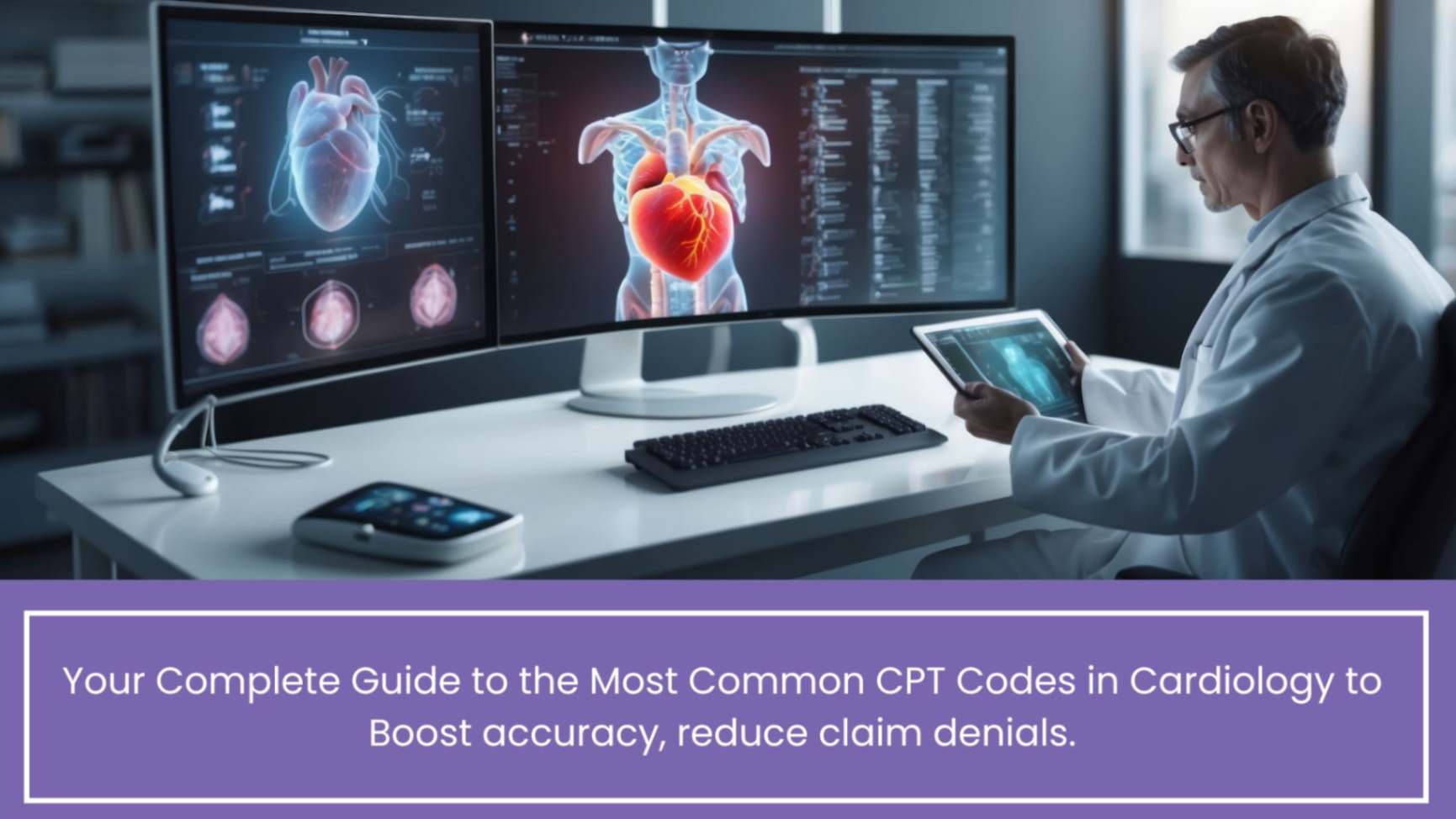Most Common CPT Codes in Cardiology
Getting to know the Most Common CPT Codes in Cardiology can save you tons of time and headaches. From CPT codes used in cardiac catheterization to electrophysiology CPT codes examples and Echocardiography CPT codes explained, knowing the details means fewer claim denials and faster reimbursements. In this blog, we’ll walk you through medical billing cardiology CPT 93458 92928 etc, show you how to code CPT 93306 echo, explain the difference between CPT 93000 vs 93010, and highlight best practices documentation modifiers cardiology CPT. Plus, we’ll cover ICD-10 pairings for cardiology CPT codes and the recent updates cardiology CPT codes 2025 — all made simple by Practolytics.
Let’s be honest — coding in cardiology isn’t a walk in the park. Between diagnostic tests, procedures, and payer rules that change every year, it’s easy to get lost in the numbers. But understanding the Most Common CPT Codes in Cardiology can completely transform how smoothly your billing runs.
At Practolytics, we work with cardiology practices across the U.S., helping them decode (literally!) the complex world of CPT codes. Whether it’s a simple ECG or a tricky stent placement, picking the right code makes all the difference — either you get paid quickly, or you end up chasing denials.
Let’s break it down and make it all easy to understand.
Table of Contents
Understanding CPT Codes in Cardiology
Think of CPT — short for Current Procedural Terminology — as the AMA’s way of keeping Healthcare RCM services organized and easy to report.
In cardiology, CPT codes help describe everything from simple ECG readings to high-end procedures like cardiac catheterization and electrophysiology studies.
Here’s a quick snapshot:
- CPT codes used in cardiac catheterization cover diagnostic or interventional heart procedures.
- Electrophysiology CPT codes examples include procedures that diagnose and treat heart rhythm issues.
- Echocardiography CPT codes explained helps differentiate between transthoracic, stress, and Doppler studies.
And yes, knowing the difference between CPT 93000 vs 93010 is a big deal! One covers both performance and interpretation of an ECG, while the other is interpretation-only.
Get it right — you get paid. Get it wrong — hello, denial letters.
Overview and Trends for Cardiology Procedural Coding
Cardiology coding isn’t just about memorizing numbers — it’s about understanding how those numbers connect to real-world workflows and payer policies.
Here are some big trends shaping the space:
Automation and AI in Cardiology Coding
Practices are moving toward AI-assisted tools that help flag missing documentation, check modifiers, and auto-suggest the right CPT code.
Real-time RCM Integration
Integrating coding into your Revenue Cycle Management Services Healthcare platform lets you spot denials early and fix them before submission.
Annual CPT Updates
Every year, AMA tweaks CPT descriptions and introduces new ones. The recent updates cardiology CPT codes 2025 include clarifications around imaging bundling and PCI procedures.
At Practolytics, we’re obsessed with staying ahead of those changes. We monitor updates, train teams, and even automate alert systems so you don’t have to memorize every single change.
Top 10 Most Common CPT Codes in Cardiology
Let’s look at the heavy hitters — the codes cardiology practices use the most.
|
CPT Code |
Description |
Why It Matters |
|
93000 |
ECG with interpretation and report |
Standard baseline test for most cardiac visits |
|
93010 |
ECG interpretation only |
Used when another clinician performs the tracing |
|
93306 |
Complete transthoracic echocardiography |
Full echo including Doppler and imaging |
|
93458 |
Left heart cath including coronary angiography |
Core diagnostic and interventional code |
|
92928 |
PCI with stent placement |
One of the most reimbursed interventional codes |
|
93015 |
Complete cardiac stress test |
Commonly used for functional cardiac assessments |
|
93350 |
Stress echocardiography |
Combines exercise and imaging |
|
93613 |
Electrophysiology mapping and ablation |
For diagnosing and treating arrhythmias |
|
93016 |
Supervision only for ECG or stress test |
Used when the physician supervises but doesn’t perform |
|
93320 |
Doppler echocardiography |
For assessing blood flow and cardiac function |
Pro Tip from Practolytics: When billing for echo procedures, remember to use the right combination. For instance, how to code CPT 93306 echo correctly depends on whether Doppler and color flow studies are included.
And for PCI procedures, codes like billing cardiology CPT 93458 92928 etc need precise modifier documentation and sometimes ICD-10 pairings for cardiology CPT codes to justify medical necessity.
Common Documentation & Modifier Challenges
Even the most skilled cardiologists can lose revenue due to small documentation gaps. The most frequent issues include:
- Missing best practices documentation modifiers cardiology CPT
- Forgetting to include supervision details (especially for CPT 93000 vs 93010)
- Incorrectly reporting bundled codes
- Not linking appropriate ICD-10 pairings
That’s where Practolytics comes in. Our team reviews claims line-by-line, ensures the cardiology CPT codes list with descriptions is applied correctly, and checks modifiers for compliance before submission.
How Practolytics Simplifies Cardiology Billing?
Our mission is simple — let doctors focus on patient care while we handle the billing chaos.
Here’s how we do it:
Expert Coding Review:
Our certified coders ensure every code — from CPT 93458 to CPT 93306 — is used accurately.
End-to-End RCM Integration:
We combine coding, charge capture, and claim submission in one seamless workflow.
Denial Management:
Our AI-assisted RCM tools automatically flag potential errors so denials drop dramatically.
Compliance and Updates:
We stay aligned with recent updates cardiology CPT codes 2025, HIPAA standards, and payer guidelines.
Data-Driven Analytics:
We deliver custom dashboards so you can see your revenue cycle performance in real time.
Revenue Cycle Management Services Healthcare – Why
It’s the Backbone of Cardiology Billing
Today’s healthcare system is complicated, and managing your Revenue Cycle Management Services Healthcare process effectively can make or break your bottom line.
Here’s how Practolytics fits in:
- We process over 5 million claims annually.
- We serve across 31 states with 1400+ active providers.
- We maintain a 97% first-pass claim ratio.
That means fewer denials, faster payments, and more cash flow for your practice.
Key Components of Healthcare RCM
Patient Pre-registration and Registration:
We verify insurance eligibility upfront to avoid delays.
Charge Capture:
Every cardiology procedure — echo, cath, or stress test — gets accurately captured and coded.
1.Claims Submission:
Our RCM software ensures clean claim submission.
2.Payment Posting:
Every dollar from payers and patients is tracked and reconciled.
3.Denial Management:
Our team investigates and corrects denials fast.
4.Patient Collections:
Automated reminders help collect outstanding balances smoothly.
Implementing end-to-end healthcare revenue cycle management solutions can reduce costs by up to 15% and increase revenue by 3%.
Why Choose Practolytics as Your Trusted Partner?
Because we don’t just “do billing” — we build revenue systems that actually work.
Here’s what sets us apart:
- 20+ years of experience in healthcare billing.
- Dedicated cardiology billing experts.
- End-to-end automation and predictive analytics.
- Hands-on account management for every client.
- HIPAA-compliant processes and data security.
We don’t just plug codes into software — we help you understand your entire financial ecosystem, from modifiers to denials to reimbursements.
Emerging Trends and Future CPT Code Updates
Cardiology billing services isn’t standing still — and neither are CPT codes. Here’s what’s coming up in recent updates cardiology CPT codes 2025:
- Expansion of bundled codes for interventional procedures.
- Enhanced definitions for electrophysiology CPT codes examples.
- Revised payment rates for Echocardiography CPT codes explained procedures.
- New modifiers to track telecardiology and remote monitoring.
Practolytics constantly updates our clients about these changes — through newsletters, webinars, and custom coding reports.
Best Practices for Cardiology Coding Success
To keep denials low and cash flow high, follow these tips from our experts:
- Always document medical necessity for each test or procedure.
- Link correct ICD-10 pairings for cardiology CPT codes.
- Double-check billing cardiology CPT 93458 92928 etc for bundling and modifier accuracy.
- Use technology to flag missing or mismatched documentation.
- Train your staff on recent updates cardiology CPT codes 2025 regularly.
Remember — coding isn’t just admin work; it’s a revenue driver when done right.
Conclusion:
Mastering the Common CPT Codes in Cardiology is about more than compliance — it’s about building a stable, profitable practice. Whether you’re managing Echocardiography CPT codes explained, CPT codes used in cardiac catheterization, or keeping track of recent updates cardiology CPT codes 2025, every detail matters.
At Practolytics, we’ve got your back. From medical coding and billing services to compliance and analytics, we handle it all — so you can stay focused on patient care. Consider us your billing support team, quietly keeping things running like a steady heartbeat. Let’s make cardiology billing simple, stress-free, and efficient — just how your practice deserves.
What’s the CPT code for a complete ECG, including interpretation and report?
That would be CPT 93000. It covers both doing the ECG and interpreting the results — the full deal.
When should a doctor use 93010 instead of 93000 for ECG services?
Use CPT 93010 when you’re just interpreting the ECG and not the one actually performing it.
How do you code a stress test when you perform and interpret the whole thing?
That’s CPT 93015 — it includes the supervision, performance, and interpretation all in one code.
What if you’re only supervising a stress test?
Go with CPT 93016. This code is for when you’re overseeing the test but not physically running it.
What code should you use for PCI (stent placement)?
That’s CPT 92928. It’s used for PCI procedures involving stent placement. Just remember to include the right modifiers if you’re treating more than one vessel.
ALSO READ – Decoding CPT: Your Guide to Codes and Regulations 2024
Talk to Medical Billing Expert Today — Get a Free Demo Now!






